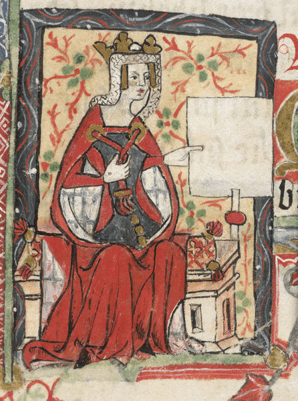Written by Chris Riley
In 1127, seven years after loosing his only legitimate son in ‘The White Ship Disaster’, King Henry I of England and Normandy had his nobles swear to recognise his only remaining legitimate child as his heir. Matilda, who had spent her youth as Holy Roman Empress, learning how to rule and how to navigate the difficult medieval political scene, was primed to claim her birth right backed by the leading lords and barons of the realm. Instead of a simple exchange of power, on the death of Henry I in 1135, a 19 year long struggle and civil war erupted. Why was the only legitimate child of a reigning monarch unable to claim her throne?
The White Ship Disaster and the line of succession
Matilda was born on 7th February 1102 and before she was even a teenager, was sent to Germany to marry Henry V, soon to be Holy Roman Emperor. The marriage between the child Matilda and her adult counterpart did not yield any children but, gave the young Matilda (who styled herself as ‘Empress’ for most of her adult life) a wonderful political education, acting as regent in both Germany and Italy as her husband was often off on campaign.

Tragedy struck Matilda three times within just seven years when her mother, Matilda of Scotland died in 1118, her brother, William ‘Adelin’ (an Anglo-Norman nickname that meant heir to the throne) died in the afore mentioned White Ship Disaster, which saw a ship carrying 300 of the most important young courtiers of both England and Normandy, die in a ship wreck off the Normandy coast. In 1125, she was made a widow at the age of just 23 when her Husband Henry, died of cancer, leaving Matilda with a decision to make, either find herself fading into religious obscurity as a nun or, pursue her birthright back in England.

By 1127, Henry had his nobles recognise Matilda as heir and, had her married off to Geoffrey, Count of Anjou, a historical rival of the Normans and not a fair match in Matilda’s eyes. The couple (Matilda was 25 when she married the 14 year old Geoffrey) failed to get on immediately with the two disagreeing on virtually everything. To Matilda, Geoffrey was a mere Count and she was an empress and soon to be queen whilst Geoffrey was a bad tempered teenager with ideas above his station. The young couple eventually made up and by 1132, Matilda was finally pregnant and would give birth to a healthy baby boy in 1133 obviously, named after her father, King Henry.

By 1134, Matilda had two sons with the second pregnancy almost killing her, but things would go from bad to worse when Geoffrey argued with her father over Matilda’s dower lands in Normandy. In 1135, before the two sides could kiss and make up, Henry died after eating too many lampreys (slightly fancier eels).
Stephen of Blois and The Anarchy
Upon hearing the news of her father’s death, Matilda was still in Anjou but someone who has not yet been mentioned was already in England, with the crown on his head. Stephen, Count of Blois was the nephew and favourite of Henry I and upon his uncle’s death, raced to meet his bother Henry who was Bishop of Winchester, and seized the royal treasury and the crown. Stephen had been present in 1127 when the oath to see Matilda on the throne was made, but chose to go against it and many a Baron and Lord followed suit.
What followed Stephen’s crowning was a near two decade conflict between the crowned Stephen and the uncrowned but holy determined Empress Matilda. By 1138, Matilda was ready to invade and with the support of her half-brother, Robert Earl of Gloucester, was able to land in the south of England and before long, had secured most of the south of the country against Stephen. Matilda could also rely on her uncle, David King of Scots, who at the same time, launched an invasion of the north of England, further diluting Stephens forces.
By 1141, Stephen was on the ropes and after the battle of Lincoln, found himself in the custody of Matilda. With her rival in chains, Matilda was proclaimed ‘Lady of the English’ and marched on London to be crowned. It was at this time that the thought of a woman, as monarch in her own right dawned on the leading men of the realm and the situation soon turned sour. The simple fact of the matter was, regardless of her royal pedigree, excellent political experience and autocratic know-how, the idea of a Queen of England was just too radical for most to accept, the London mob soon turned on her, dashing her chances of being crowned.
‘The Anarchy’ continued into the 1150’s and after Stephen was released (to secure the release of Robert of Gloucester who had been captured himself) and Matilda was almost captured at the siege of Oxford in 1142, Matilda decided to put her effort into her son Henry who took up the mantle of would-be monarch.
The sad reality
After the debacle of 1141-42, it was clear that the crowning of Henry would be the closest that Matilda would come to being queen. Henry was made Stephen’s Heir in 1153, a few short months before the old king’s death in 1154. He was crowned King Henry II in the smoothest transition of power since before the conquest. Matilda’s hard work and determination to continue to pursue her claim, saw her son on her throne and every single England and British monarch can trace their ancestry through Matilda.
Even though Matilda never became Queen, her legacy and importance cannot be understated. Her absolute determination, drive and political savvy righted the wrong (if you see it that way like me) of the reign of Stephen and repeatedly ignored the opinions of her male contemporaries who saw her as an upstart woman who should have been the ‘noble and beautiful’ second in command to a father, husband or son.
Matilda’s tombstone reads “Great by birth, greater by marriage, greatest in her offspring: here lies Matilda, the daughter, wife, and mother of Henry” a complete understatement and proof that Matilda’s gender was seen as a major issue when considering her for the crown. On every level, Matilda would have likely made a great Queen but at the very least, her model for how a Queen Mother and Regent should be would be used by her daughter-in-law, the equally brilliant Eleanor of aquitaine and all future female monarchs.
I hope you enjoyed this and would love to hear what you think, follow me on Instagram @chrisriley_and check out thehistorycorner.org for more history!
Thanks for Reading.
Reference:
Hanley, C (2019) Matilda: Empress, Queen, Warrior, Yale University Press.


This is the best story of all. Thank you.
M. Was born 2-7-02. I was born 2-2-50. She defeated Stephen (for a moment) on 2-2. 🥳
LikeLiked by 1 person